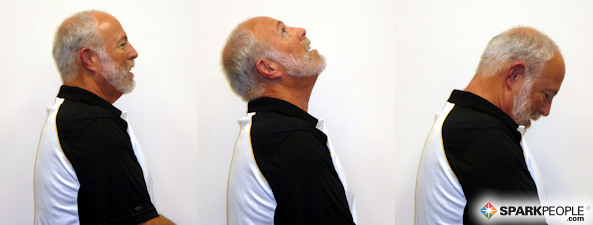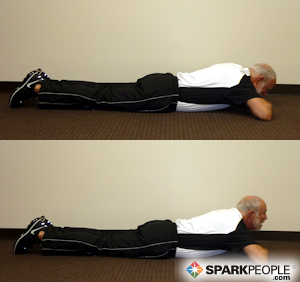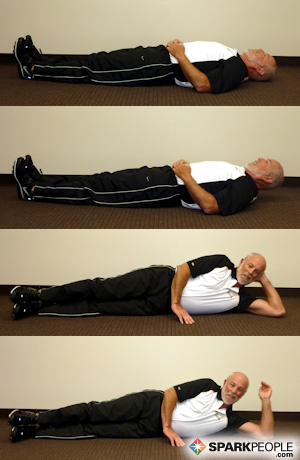|
Neck pain is one of the most common problems that many of us experience. Studies show that 30% of people experience neck pain, with women affected more often than men. The neck includes seven segments (or vertebrae) with discs acting as shock-absorbers between the segments. The vertebrae are supported by 18 groups of muscles that maintain support and allow function. Why so many muscles? Well, the head weighs about 10 pounds and sits about 10 inches above the shoulders with only the neck to support it. No wonder it gets sore from time to time! So, how do we keep our neck healthy and strong? The answer is maintaining motion and strength exercises. So let’s look at both. And remember, if you experience pain, stop the exercise and consult your doctor. And don’t feel you have to do all of the exercises. Pick the ones that help the most and don’t cause increased pain. Motion Exercises The neck moves in three planes (or directions) including forward, back, side to side, and rotation. You can do these exercises any time or place (except maybe while driving a car). Try to get into a routine that goes through all planes in the same sequence so you don’t miss any. Exercise 1: Let's start either sitting or standing with the head in neutral position. Look up at the ceiling and then down at the floor in a gentle, slow rhythm. Repeat five times in each direction.  Exercise 2: Next, let’s go side to side, again with five in each direction. Try to touch your ear to your shoulder, but don’t raise the shoulder; keep it relaxed.  Exercise 3: Finally, rotate the neck to one side and then the other, trying to rotate the chin to the line of the shoulder. Repeat five times in each direction. If you feel or hear a little painless cracking, there is no cause for alarm, but talk to your doctor if you have any concerns.  Isometric Exercises These exercises allow the muscles to be strengthened without actually moving the neck. Isometrics is an effective strength training technique that can be especially helpful if you are experiencing painful motion of a joint, or in this case, the neck in general. Again, these exercises can be done standing or sitting.  Exercise 1: Place both hands behind your neck, interlocking the fingers with the palms cradling the back of the head. You are now going to do two things simultaneously: pull forward with the hands and extend your neck backward. Hold this position for ten seconds and then relax. The idea is to feel the muscles in the back of the neck contracting without the neck itself moving. The more you pull forward, the more you have to tighten the muscles to keep the neck in a neutral position. The benefit here is that you can create more or less tension quickly and easily. This will help avoid injury while allowing you to progress to higher tension levels as you get stronger. Exercise 1: Place both hands behind your neck, interlocking the fingers with the palms cradling the back of the head. You are now going to do two things simultaneously: pull forward with the hands and extend your neck backward. Hold this position for ten seconds and then relax. The idea is to feel the muscles in the back of the neck contracting without the neck itself moving. The more you pull forward, the more you have to tighten the muscles to keep the neck in a neutral position. The benefit here is that you can create more or less tension quickly and easily. This will help avoid injury while allowing you to progress to higher tension levels as you get stronger. Exercise 2: Next, place one palm on your forehead as if you were feeling for a temperature. Place the other hand over the first one and try to tilt the head forward, holding a neutral position by pushing back with the hands. Hold for ten seconds and relax. Exercise 2: Next, place one palm on your forehead as if you were feeling for a temperature. Place the other hand over the first one and try to tilt the head forward, holding a neutral position by pushing back with the hands. Hold for ten seconds and relax. Exercise 3: Next, work each side of the neck by placing a hand against the side of the head, using the opposite hand to support the wrist of the pushing hand. Try to tilt the head toward the shoulder while keeping a neutral position by pushing back with the hand. Hold for 10 seconds, relax, and do the other side. Exercise 3: Next, work each side of the neck by placing a hand against the side of the head, using the opposite hand to support the wrist of the pushing hand. Try to tilt the head toward the shoulder while keeping a neutral position by pushing back with the hand. Hold for 10 seconds, relax, and do the other side. Exercise 4: Finally, let’s perform isometric rotation strengthening by placing one hand against the chin with the palm cupping the front of the chin. Again, use the opposite hand to support the wrist of the pushing hand. Try to rotate the head while pushing back with the hand. After 10 seconds, relax and do the opposite side. Exercise 4: Finally, let’s perform isometric rotation strengthening by placing one hand against the chin with the palm cupping the front of the chin. Again, use the opposite hand to support the wrist of the pushing hand. Try to rotate the head while pushing back with the hand. After 10 seconds, relax and do the opposite side. Dynamic Strengthening Exercises  The last set of exercises uses that 10 pound weight sitting above your shoulders to allow motion and strengthening at the same time. This time, we are going to do flexion, extension and lateral bending, but not rotation. The last set of exercises uses that 10 pound weight sitting above your shoulders to allow motion and strengthening at the same time. This time, we are going to do flexion, extension and lateral bending, but not rotation.Exercise 1: Start by lying on the floor or mat on your belly. Rest your head on a small pillow, or use your hands to cushion your head in the neutral position. Then, raise the head off the floor and hold the extended position for up to 30 seconds if you can. Relax back down.  Exercise 2: Roll over on your back and flex the neck, holding the head off the floor for 30 seconds. Then, relax again. Then, roll to one side, supporting the head in a neutral position with downside arm and hand in a flexed position. Tilt the head away from the hand and hold for 30 seconds. Relax back down and switch to the opposite side. Exercise 2: Roll over on your back and flex the neck, holding the head off the floor for 30 seconds. Then, relax again. Then, roll to one side, supporting the head in a neutral position with downside arm and hand in a flexed position. Tilt the head away from the hand and hold for 30 seconds. Relax back down and switch to the opposite side.There you have it! In less than five minutes, you can use this easy routine to keep your neck healthy and avoid that nagging pain in the neck. Try doing it every day to get the best results. Use it to complement your regular full-body workout routine, especially if you are prone to neck pain. You will be amazed at how well it works! About the Author .jpg) Dr. Thomas J. Kleeman, MD, is nationally-renowned orthopedic surgeon and founder of the New Hampshire Neurospine Institute. With the help of his wife Anne, he has become dedicated to the use of exercise and good nutrition as a means of maintaining quality of life during the aging process. Now 66, he is a cancer survivor who found the benefits of exercise and nutrition instrumental in his own recovery. Along with his wife Anne, a registered nurse and certified fitness professional Dr. Thomas J. Kleeman, MD, is nationally-renowned orthopedic surgeon and founder of the New Hampshire Neurospine Institute. With the help of his wife Anne, he has become dedicated to the use of exercise and good nutrition as a means of maintaining quality of life during the aging process. Now 66, he is a cancer survivor who found the benefits of exercise and nutrition instrumental in his own recovery. Along with his wife Anne, a registered nurse and certified fitness professional. |
Popular EntriesRelated Entries
More From SparkPeople
|






















